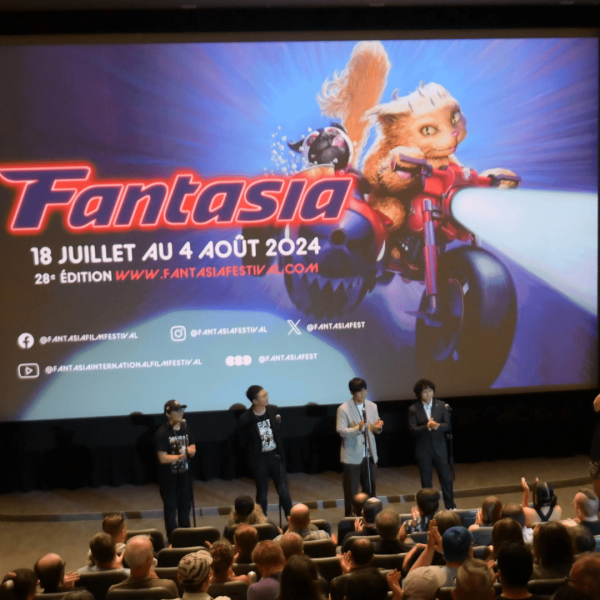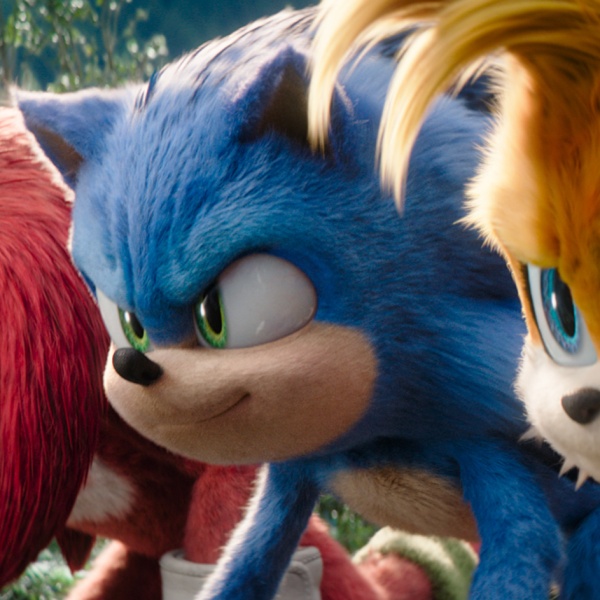While it’s too easy to consider filmmaker Wes Anderson’s cinematic world one entirely of his own creation, the iconoclastic creator’s impeccably built tales have always hinged on his long-running professional bonds with everyone from his perpetual co-writer Roman Coppola to his merry band of performers (the Wilson brothers, Jason Schwartzman, Edward Norton, Jeff Goldblum, Adrien Brody, Tilda Swinton, Anjelica Huston, the list goes on and on and can happily feed dozens of new productions).
And, of course, there’s been Roald Dahl.
While the iconic if controversial British author passed away before Anderson even shot his first feature, “Bottle Rocket,” the mannered and fantastical world the “James and the Giant Peach” and “Charlie and the Chocolate Factory” author built on the page is a striking match for Anderson’s cinematic obsessions.
In 2009, Anderson tried his hand at his first Dahl adaptation with his winsome and charming stop-motion feature “Fantastic Mr. Fox” and now, nearly 15 years later, Anderson wades even deeper into the rich waters of Dahl’s bibliography with his latest work: a series of short films based on some of Dahl’s short stories. While the project was first believed to be a feature-length adaptation of “The Wonderful World of Henry Sugar,” the package is bigger than that, with Anderson taking four of Dahl’s stories and turning them into a witty package of distinctly Anderson-ian endeavors, all bolstered by the work of Anderson’s usual collaborators (and the addition of Benedict Cumberbatch as the titular Henry Sugar).
All of the four short films are now streaming on Netflix, and while they can be enjoyed as single-serving delights, they make a winning, feature-length treat when consumed together. Ahead, we rank the four-pack, and perhaps give some insight into the best way to watch them as a set (with a generous notation on any shorts that might, ahem, ruffle the feathers of the more tender-hearted).
-
1. “The Wonderful Story of Henry Sugar”

Image Credit: Courtesy of Netflix The title story of Roald Dahl’s anthology is also the clear and inevitable standout among Wes Anderson’s quartet — please can we call it a “quadrilogy?” — of adaptations, and not only because it’s 20 minutes longer than the rest of the episodes. A globe-trotting epic among a collection of single-location miniatures, “The Wonderful Story of Henry Sugar” is not only the most restless and visually inventive film that Anderson has made thus far (its in-your-face theatricality and manic bricolage of nested subplots so aggressive that even the recent “Asteroid City” feels measured by comparison), it acts as a mission statement of sorts for the greater “Henry Sugar” enterprise, and project, and confirms the Netflix project as yet another vital chapter in the filmmaker’s career-long obsession with self-understanding in a senseless world.
Like “Asteroid City” before it, “Henry Sugar” overtly explores how storytelling can serve as an avenue toward life’s greatest truths, but where that movie was preoccupied with finding solace in the unknown, this one hinges on using artifice to see through all the bullshit. If Dahl’s story — about a London playboy whose meeting with an Indian circus performer named Imhrat Khan teaches him to see the world more clearly with eyes closed — was a rebuttal to all the critics who accused him of being too mean, Anderson’s film is an unambiguous middle finger to anyone who thinks his stuff is all style and no substance.
But the style here sure is outrageous, as the hermetic nature of Dahl’s plot gives Anderson the chance to make something that has no grounding in reality. There isn’t any “now” in “Henry Sugar,” nor a single moment when its story exists apart from its telling. All five of the film’s actors play multiple roles, and even the most dramatic changes of scenery are seamlessly accomplished with a simple move of Robert Yeoman’s camera, which dollies right just in time for Dahl to pass the narrator’s baton to Mr. Sugar himself (Anderson newcomer Benedict Cumberbatch, a natural addition to the filmmaker’s troupe).
Dahl’s text is elided somewhat, but the parts that remain are read word-for-word, down to each individual “he said” (imagine listening to the best-performed audio book you’ve ever heard played at 4x speed). When Richard Ayoade tells us that his character’s “whole face was rigid with shocked disbelief,” he then turns to flash the camera what that expression might look like. That kind of breakneck cleverness proves typical of a short that takes every sentence as a personal challenge to do something fun with it.
It also proves typical of a short that constantly recites information in the driest way possible, only to then immediately add a layer of fourth-wall-breaking fakery on top of it that brings it to life — an approach that becomes all the more brilliant as Henry Sugar’s fascination with artifice begins leading him toward deeper truths. Khan’s powers are so incredible that Henry thinks they must be a trick, but further investigation suggests that the real falsehoods lie in his own conception of reality. No wonder Anderson has now adapted Dahl twice.
“The audience loves it,” Dahl wrote. “They applaud long and loud. But not one single person believes it to be genuine. Everyone thinks it is just another clever trick. And the fact that I am a conjurer makes them think more than ever that I am faking. Conjurers are men who trick you. They trick you with cleverness. And so no one believes me. Even the doctors who blindfold me in the most expert way refuse to believe that anyone can see without his eyes. They forget there may be other ways of sending the image to the brain.” —DE
-
2. “Poison”

Image Credit: Courtesy of Netflix In some ways the darkest of the four Dahl stories adapted for this project (though it has ample competition in that regard), “Poison” finds Anderson leaning on one of the few sensations that has been largely absent from his body of work until now: suspense. Suspense in the purest and most Hitchcockian definition of the word. The suspense you might expect from a tale about a man (Benedict Cumberbatch) who discovers that a deadly Indian krait snake has curled around his belly as he lies in bed, and then summons a doctor (Ben Kingsley) in the middle of the night to see if he can remove the venomous reptile from between the sheets before it bites anyone.
The situation unfolds with the breathlessness of a bomb disposal (its natural anxieties both heightened and complicated by the colonialist power dynamics of a white patient relying upon the help of an Indian medic), and while Anderson’s arch comic style might seem poorly suited to raw suspense, Dev Patel’s mile-a-minute narration only adds to the intensity of a scenario that has less to do with snake bites than it does a different and more pernicious kind of venom.
Covered in flop-sweat from start to finish, Cumberbatch hasn’t been quite this slimy in any respect since the days of “Atonement,” while Kingsley is droll and graceful in equal measure, and Patel heartrendingly mediates a crisis that only starts to sting once the snake has been removed from the story altogether. Despite Anderson’s fidelity to Dahl’s text, he manages to frame the ending in a way that makes it considerably more damning on screen than it does on the page; regardless of what happened to that Indian krait, this story has never had more bite. —DE
-
3. “The Swan”

Image Credit: Courtesy of Netflix I’ve gotta be honest: I’ve never made a ton of time for Rupert Friend, a British actor who brought a memorable, Rufus Sewell-esque sliminess to his role as Mr. Wickham in Joe Wright’s “Pride & Prejudice,” only to largely disappear from the silver screen after landing a lead role in Showtime’s “Homeland,” which — sight unseen — also struck me as a talent incubator in the form of a television program. More recent turns in “The Death of Stalin” and “A Simple Favor” began to suggest that Friend had more to offer the movies than he’d shown thus far, but God bless Wes Anderson for knowing exactly what it was (Anderson’s ability to identify which actors might fit into his hyper-rigid universe is so immense that it’s easy to overlook completely).
There are high-wire “how did they do that?” performances in each of the four shorts in Anderson’s Netflix shorts, but none of them betray a greater degree of difficulty than Friend’s all-encompassing turn(s) in “The Swan.” A cruel and sad little gut-punch of a story about a sweet, bird-loving boy named Peter Watson who’s mercilessly bullied by a pair of 15-year-old bird-killers after one of them gets a rifle for his 15th birthday, “The Swan” was born from a haunting incident that Dahl read about in the backpages of a newspaper one day; an incident that highlighted the ugliness that innocence tends to provoke from people out of spite.
In addition to narrating the tale as the adult Peter Watson, who confesses the events to the camera with devastating matter-of-factness, Friend also embodies the two kids who bullied young Peter, which he accomplishes simply by throwing his voice into what sounds like a Barry Keoghan impression; the effect is that of an adult man who’s still in dialogue with his most devastating childhood trauma. Framed by stark backdrops and a funereal color palette that tempers the discomfiting comedy of his performance with an implacable veneer of sadness, Friend tears through this awful story as if it’s been metastasizing inside of him for his entire life, and he does so without a trace of self-pity. That proves essential to Anderson’s withering adaptation, which reserves the brunt of its pity not for Peter Watson, that poor boy, but rather for a world too brutish to embrace the beauty he fought to protect. —DE
-
4. “The Rat Catcher”

Image Credit: Courtesy of Netflix Anderson is no stranger to dramatizing the animal world through delightful stop-motion animation (heck, he even did just that with Dahl’s own work before the “Henry Sugar” set, thanks to the aforementioned “Fantastic Mr. Fox”), but while one might hope such cheer will appear in “The Rat Catcher,” be warned: the one animal we actually see (more on that in a moment) is hardly of the peppy and cute variety.
While “The Rat Catcher” is rife with the usual Anderson obsessions — we’ve got Richard Ayoade narrating it as a plucky newspaperman (an incredible feat of monologuing that should not be overlooked), Ralph Fiennes as the titular “rodent operative,” a wonderfully game Rupert Friend as both a local mechanic and a Fiennes foe, and a mysterious hayrick rife with rats — it also takes on a darker cast as its 17-minute running time chugs along.
Fiennes has been dispatched to a local hamlet to exterminate a hoard of rats gnawing their way around a hayrick, he also appears in a second role (as Dahl himself, narrating the whole thing), while Friend seamlessly moves from standoffish local to rat stand-in with ease. It’s Fiennes, however, who really goes for it, including miming a series of interactions with rats and ferrets (oh my!) that rely on his play-acting techniques to sell the story (again, there’s only a single stop-motion rat here, and he’s not the one wrestling around in Fiennes’ shirt; yes, you read that correctly). Soon enough, the rat-faced rat catcher and Friend are facing off in a battle royale that sounds too nutty even for Anderson. The makeup is superb.
While the other shorts in the collection, particularly “The Wonderful Story of Henry Sugar” itself function beautifully as self-contained stories and parables, there’s something unfinished about “The Rat Catcher,” and viewers will probably not be surprised to learn that its final query (why didn’t those damn rats take the poisoned oats?) only gets an answer in another Dahl short. (Check out “Rummins,” and you’ll walk away from this film with an entirely different take on the material.) —KE





